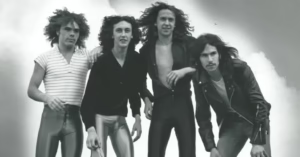Metallica: Titans of Thrash and Architects of Modern Metal
Metallica. Forged in Fire: The Early Years (1981–1983)
Metallica was formed in Los Angeles, California in 1981 when drummer Lars Ulrich, a Danish immigrant with a love for the New Wave of British Heavy Metal (NWOBHM), placed an ad in a local newspaper. Responding to the ad was James Hetfield, a rhythm guitarist and vocalist with a background in punk and hard rock. The chemistry between the two was immediate, and Metallica was born.

The early lineup was completed by Ron McGovney (bass) and Dave Mustaine (lead guitar), but both would eventually be replaced. Cliff Burton joined on bass in 1982, and his virtuosic, classically influenced playing transformed the band’s musical ambition. Just before recording their first album, Mustaine was fired due to alcohol-fueled behavior and replaced by Kirk Hammett, formerly of Exodus.
Kill ‘Em All (1983): Birth of Thrash Metal
Metallica’s debut album, Kill ‘Em All, was released in July 1983. It was aggressive, raw, and fast—fusing the energy of punk with the technicality of heavy metal. Songs like “Whiplash,” “Seek & Destroy,” and “The Four Horsemen” helped define the burgeoning thrash metal genre, alongside Slayer, Anthrax, and Megadeth (founded by Dave Mustaine after his departure).
Though not a commercial hit initially, the album would later be seen as a revolutionary moment in heavy metal, setting a blueprint for countless metal bands to come.
Ride the Lightning (1984): Maturity and Melody
The band’s second album, Ride the Lightning, marked a significant evolution. Recorded in Copenhagen, it featured more complex song structures, melodic elements, and philosophical lyrics. Tracks like:
- “Fade to Black” – a somber ballad about depression and suicide
- “Creeping Death” – a biblical epic about the Exodus
- “For Whom the Bell Tolls” – inspired by Hemingway’s novel
…showed Metallica growing artistically without losing their intensity.
Master of Puppets (1986): A Metal Masterpiece
Released in 1986, Master of Puppets is considered not only Metallica’s greatest achievement but one of the most important metal albums of all time. The album is a relentless, intricate, and powerful critique of control, addiction, and war.
The title track, “Master of Puppets,” is an eight-and-a-half-minute odyssey about substance dependence. “Battery” and “Disposable Heroes” showcased speed and aggression, while “Orion” displayed Cliff Burton’s compositional genius.
The album was their first on a major label (Elektra) and became the first thrash metal album to go platinum without radio airplay or music videos.
Metallica. Tragedy Strikes: Death of Cliff Burton (1986)
During the Damage, Inc. tour in Sweden, on September 27, 1986, Metallica’s tour bus crashed. Cliff Burton was killed, and the band was devastated. He was just 24.
Burton’s death was a pivotal moment. Metallica nearly disbanded but decided to continue, bringing in Jason Newsted (formerly of Flotsam and Jetsam) as their new bassist.

…And Justice for All (1988): Political Rage and Sonic Precision
Their fourth album, …And Justice for All, was released in 1988 and was a cold, complex, and clinical exploration of injustice, war, and corruption. Tracks like:
- “One” – a harrowing story of a soldier maimed in war, accompanied by their first music video
- “Blackened” – an ecological warning
- “Harvester of Sorrow” – a psychological descent into madness
…cemented Metallica’s reputation for intellectual, epic songwriting.
Controversially, Newsted’s bass was nearly inaudible in the mix—a decision often attributed to lingering grief and dynamics within the band.

The Black Album (1991): Global Dominance
With producer Bob Rock, Metallica embraced a new sound on their self-titled album, widely known as The Black Album. It was slower, groovier, more accessible, and it catapulted them to superstardom.
- “Enter Sandman” became a stadium anthem.
- “The Unforgiven”, “Nothing Else Matters”, and “Sad But True” showcased emotional depth and sonic power.
- The album topped charts worldwide and sold over 30 million copies, transforming Metallica into a global phenomenon.
Metallica. Controversy and Experimentation (1996–2003)
Metallica’s next two albums, Load (1996) and Reload (1997), saw the band exploring blues rock, southern rock, and alternative metal. Though both albums sold well, fans were divided over the new sound—and image (short hair, eyeliner, and leather suits).
In 2000, Metallica sued Napster, a file-sharing service, igniting a war between musicians and digital piracy. While the band was criticized for its stance, the case became a landmark moment in digital media history.
In 2001, Jason Newsted left the band, and the band nearly imploded during the recording of St. Anger (2003). The sessions were documented in the raw, revealing film Some Kind of Monster, which exposed inner turmoil, therapy sessions, and the band’s struggle to survive.
St. Anger featured no guitar solos, a raw, unpolished sound, and a snare drum tone that remains divisive. It was commercially successful but critically mixed.

Rebirth and Reinvention: Death Magnetic and Beyond
In 2008, Metallica released Death Magnetic with new bassist Robert Trujillo and producer Rick Rubin. The album marked a return to their thrash roots:
- “That Was Just Your Life”, “All Nightmare Long”, and “The Day That Never Comes” showcased intricate riffs, tempo shifts, and lyrical maturity.
In 2016, Hardwired… to Self-Destruct followed, continuing their legacy with a modern, powerful production and tracks like:
- “Moth Into Flame”
- “Spit Out the Bone”
- “Atlas, Rise!”
72 Seasons (2023): A Reflection on Identity and Time
Their most recent release, 72 Seasons (2023), delves into themes of identity, trauma, and transformation, referencing the first 18 years of life as the core of who we become.
Tracks like:
- “Lux Æterna” – a high-speed, classic metal anthem
- “If Darkness Had a Son” – exploring inner conflict
…proved that Metallica is still evolving, still relevant, and still fierce.
Metallica. Band Members (Timeline)
- James Hetfield – vocals, rhythm guitar (1981–present)
- Lars Ulrich – drums (1981–present)
- Kirk Hammett – lead guitar (1983–present)
- Cliff Burton – bass (1982–1986, deceased)
- Jason Newsted – bass (1986–2001)
- Robert Trujillo – bass (2003–present)
- Dave Mustaine – lead guitar (1981–1983)
Metallica. Discography (Studio Albums)
- Kill ‘Em All (1983)
- Ride the Lightning (1984)
- Master of Puppets (1986)
- …And Justice for All (1988)
- Metallica (The Black Album) (1991)
- Load (1996)
- Reload (1997)
- St. Anger (2003)
- Death Magnetic (2008)
- Hardwired… to Self-Destruct (2016)
- 72 Seasons (2023)
Metallica. Legacy and Cultural Impact
Metallica has sold over 125 million albums worldwide and has influenced virtually every subgenre of heavy music—from death metal and metalcore to nu metal and progressive metal.
They are known for:
- Revolutionizing metal’s mainstream appeal
- Uncompromising live performances
- Balancing artistic risk with fan expectation
Inducted into the Rock and Roll Hall of Fame in 2009, Metallica is not just a band—they are a cultural force that has outlived fads, trends, and personal chaos to remain one of the most vital acts in music history.






